Every six months or so, I write an internal reflection on the current state of cryptocurrency and share my thoughts on where it might be headed in the future. I thought it would be valuable to release my most recent article for public reading.
This review can be divided into three parts: first, the strategies or projects that are currently effective, second, other things that have happened or are in progress, and finally, new trends that I am looking forward to. I try my best to make analysis based on data, but inevitably, my personal opinions will occasionally affect my judgment. I hope this article will be inspiring for you. If I receive positive feedback or valuable opinions, I will consider continuing to share more such internal thinking in the future.
Summary
It’s encouraging to see that many initiatives and ideas are having an impact and showing serious results. These developing ideas—I call them “big ideas” because they have the potential to fundamentally change the way the status quo works—are expected to create new opportunities and have second-order effects of success.
For clarity, I use the term “working” to refer to projects or trends that are demonstrating sustainable product-market fit, are scaling the crypto market, or both.
So what programs or trends seem to be working or growing right now? Here is a (non-exhaustive) list of 10 things I think are showing clear signs of “working”:
- Stablecoins
- Bitcoin as an alternative asset
- Farcaster, an early but growing social network
- Asset Creation
- Community-created and trained AI models
- Solana
- Ethereum
- Zora
- Coinbase
- On-chain exchanges
- Bonus Project: Blackbird
#1: Stablecoins
Net supply inflows to on-chain stablecoins so far this year are around $2.5 billion. Inflows have been positive since November 2023. Permissionless global access to the U.S. dollar continues to enjoy strong market fit.
#2: Bitcoin as an alternative asset
In January, fewer than a dozen Bitcoin spot ETFs were approved. But by early June, the value of Bitcoin spot ETFs exceeded $80 billion. I mainly use data trackers from Blockworks and The Block to get relevant information.
Gold is an effective benchmark for analyzing the logic of institutions' allocation to Bitcoin: whether or not you agree that Bitcoin can be used as an inflation hedge, it is undoubtedly an alternative to the traditional stock market and has a certain social consensus on value cognition. Some people believe that Bitcoin is superior to gold in some aspects - it is easier to transfer, the supply limit is predictable, and the asset is being included in the balance sheets of some companies and countries - so it may one day surpass the gold market.
In the private markets, Q1 was particularly focused on projects that extend the utility of Bitcoin, from the many Bitcoin smart contract layers to on-chain lending protocols to exploring how to leverage Bitcoin’s economic security budget to secure other chains. I predict that the fruits of these developments will likely be felt in the second half of this year.
#3: Farcaster
Farcaster is a social networking platform based on an open protocol that has begun to show significant growth momentum.
The inflection point in its growth came in late January, around the launch of Frameworks, mini-app-like components that allow users to share and interact with content directly in the Farcaster client’s social feed.
#4: Asset Creation
The number of newly created tokens has been on a continuous upward trend recently. One effective way to track this trend is to observe the number of newly created tokens on decentralized exchanges (DEX). It seems that this activity is mainly driven by asset creation on the Base and Solana platforms.
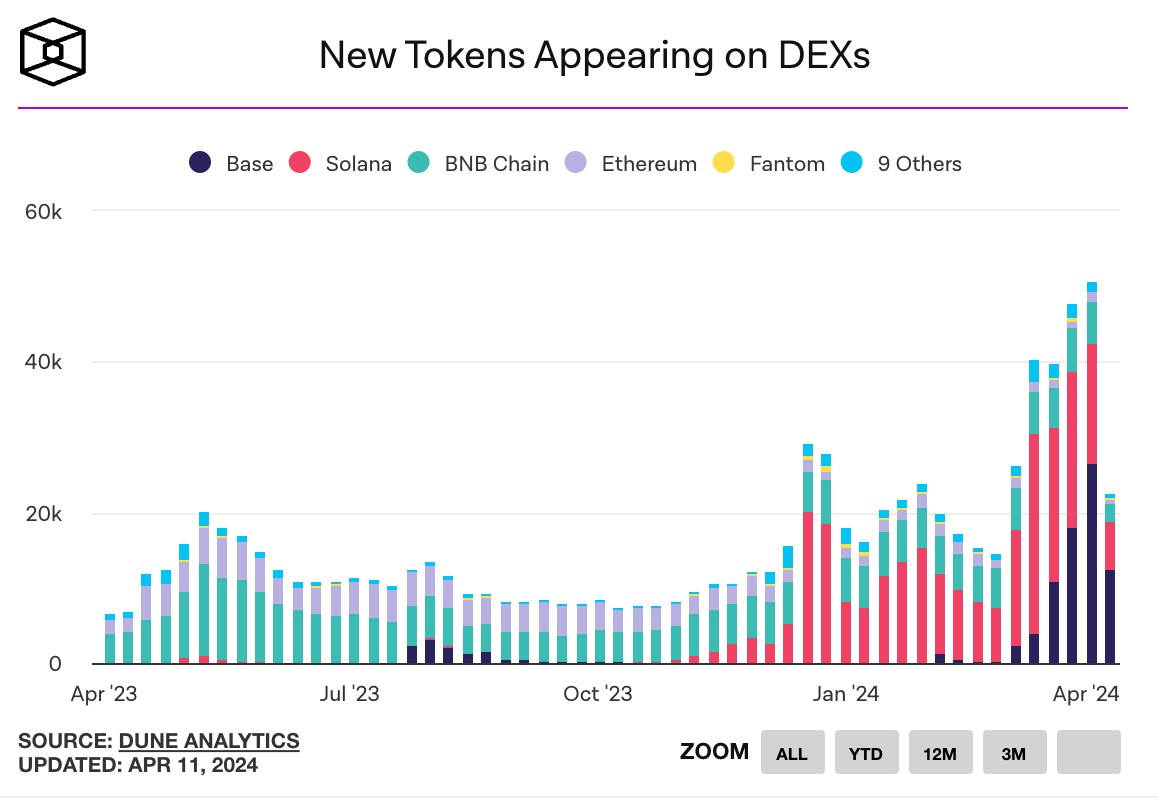
On the Solana platform in particular, more than 10,000 new tokens have been created daily in recent weeks.
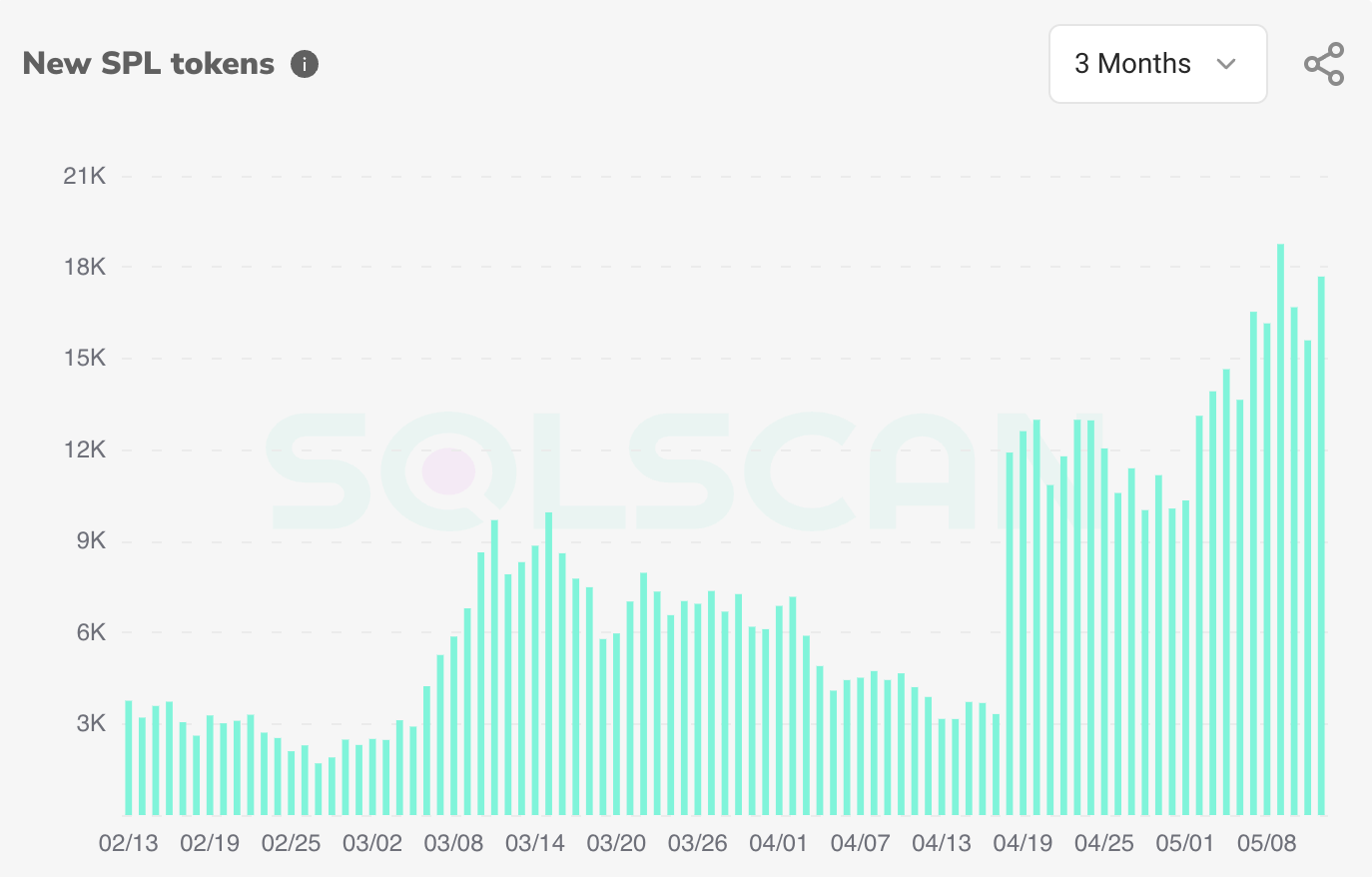
Many of these new assets take the form of memecoins (tokenized memes). While I am not active in the memecoin space, I do notice a very real and engaged community of users who are very enthusiastic about participating.
It’s worth noting that the emergence of these new assets has had some unexpected and productive side effects in the broader ecosystem. For example, we’ve seen widespread experimentation with new tools, such as Solana’s token scaling feature. A token called $BERN leverages Solana’s new token scaling technology, which innovates the token economics model: once someone sells their tokens, 5% of the tokens are destroyed as a reward mechanism for other holders. The popularity of $BERN has led to wallets adopting the token scaling standard, which has shown great utility due to its ability to enable complex payment splits and confidential transfers. Without $BERN, token scaling may have taken longer to become commonplace.
Overall, my main observation is that asset creation is clearly a smooth and natural trend. Regardless of your views on these assets, issuance and exchange are undoubtedly the two key links in the flow of value.
#5: Community-created and trained AI models
We are entering an era of cheap and diverse access to language models (LLMs), but how will value accrue in this world?
I believe that scarce resources will be the source of value. So in a world with abundant computing resources, content, and tools, the real challenge is: what is scarce? One answer is taste and attention. Taste and attention are relatively intangible resources that are difficult to quantify. While we can measure attention in some ways (such as "screen time"), translating these metrics into monetary values is challenging.
We have already begun to see how crypto can play out by tightly integrating financial activities with taste- and attention-based activities. Specifically, AI models created and trained by the community are able to generate some productive outputs — such as goods or services that can be sold or licensed (such as artwork, movies, intellectual property, etc.) — which provide the possibility of rewards for participants. For models whose outputs are more subjective, community members become tastemakers by training these models according to their own cultural preferences. People have strong incentives to choose good taste: the higher the taste, the higher its market price is usually.
We’ve seen some projects demonstrate this in a real and effective way, Botto is one of my favorite examples. As an autonomous artist, users who hold $BOTTO tokens can participate in training the model every week.
The quality of Botto’s artwork is extremely high and continues to improve, as evidenced by the rising prices of his works at auction each week. At the same time, the network of participants is expanding:
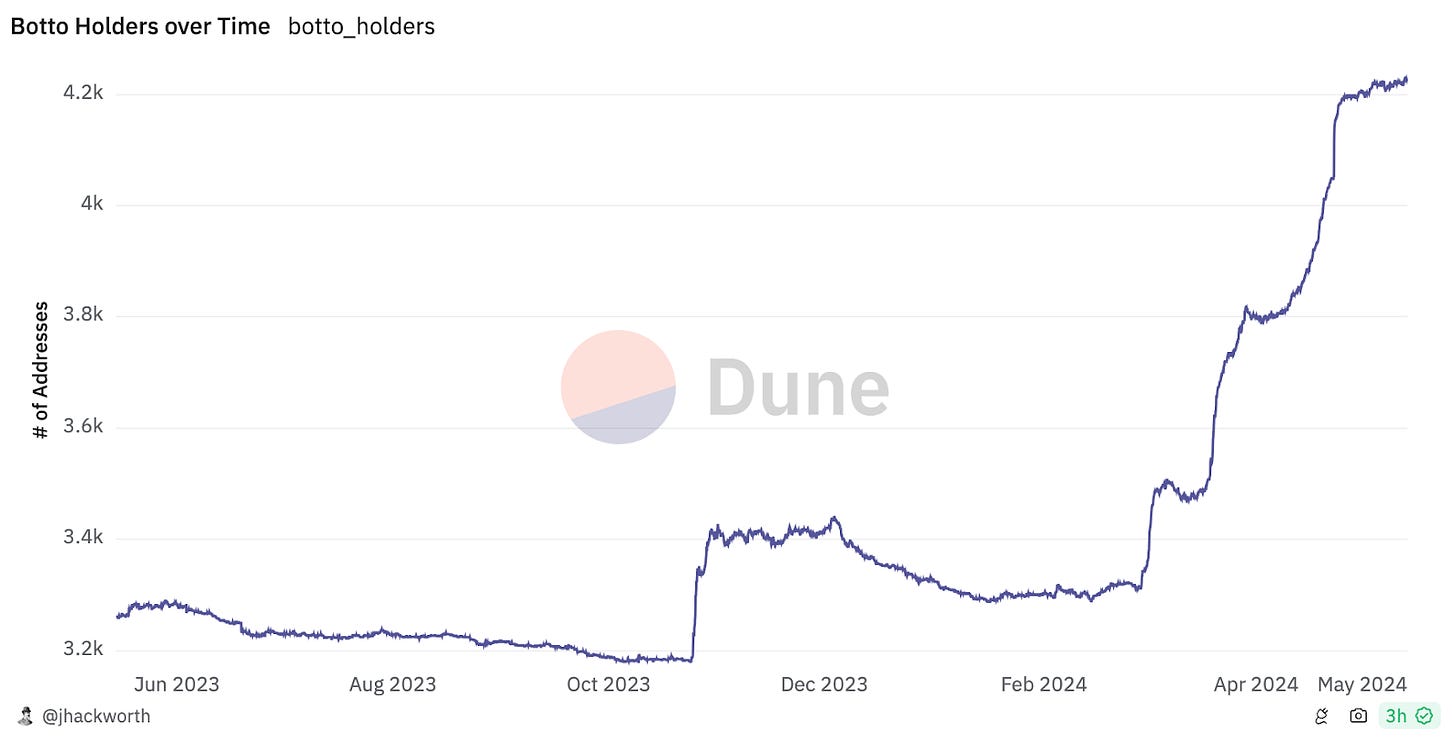
I foresee that we will see more AI models created and trained by the community in the future, especially as known and effective use cases like Botto continue to gain importance.
Some companies are responding to the top-down attribution challenge through litigation, data licensing agreements, or both. Assuming the current state accounts for less than 1% of model-based output five years from now, it is clear that there is a lot of room for attempts to solve the attribution problem and value allocation. Crypto rails offer a unique and valuable solution. Cryptocurrency enhances economic and creative attributes. This makes sense because it also allows anyone, anywhere to participate.
Chris Dixon pondered this in his blog:
“There’s a famous quote: ‘The future is already here, it’s just not evenly distributed.’ And the obvious follow-up question is: if the future is already here, where do I look for it?”
“[There is a] famous remark: ‘The future is already here – it’s just not very evenly distributed.’ An obvious follow up question is: if the future is already here, where can I find it?”
Models created and trained by the community are an area where we are watching some small but growing projects that point the way to the broader future.
#6: Solana
The number of daily active addresses interacting with the Solana network has increased by 2 to 3 times compared to the same period last year, a figure roughly equivalent to the peak of activity in 2021. During the same period, the number of monthly active addresses increased by 3 to 4 times and reached an all-time high in May 2024:
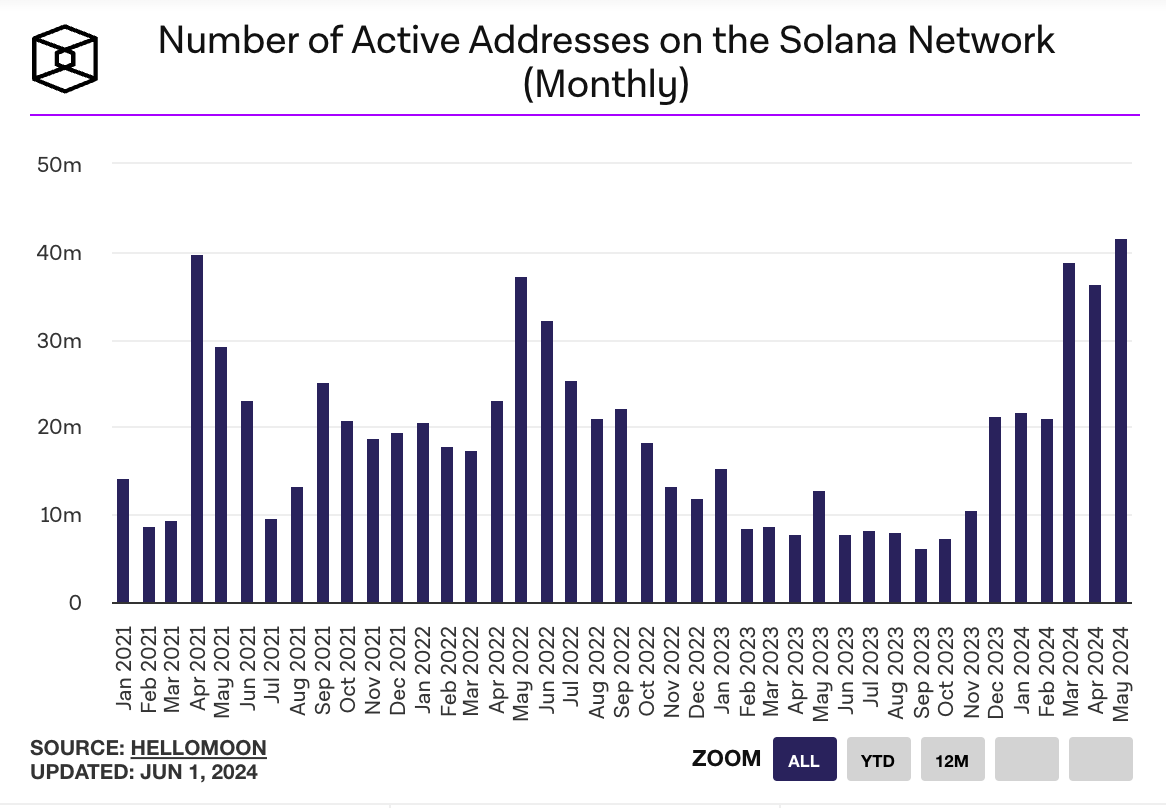
The network’s fee revenue is starting to make sense, proving the point that despite Solana’s lower fees, this cost can be offset by increased activity and number of users.
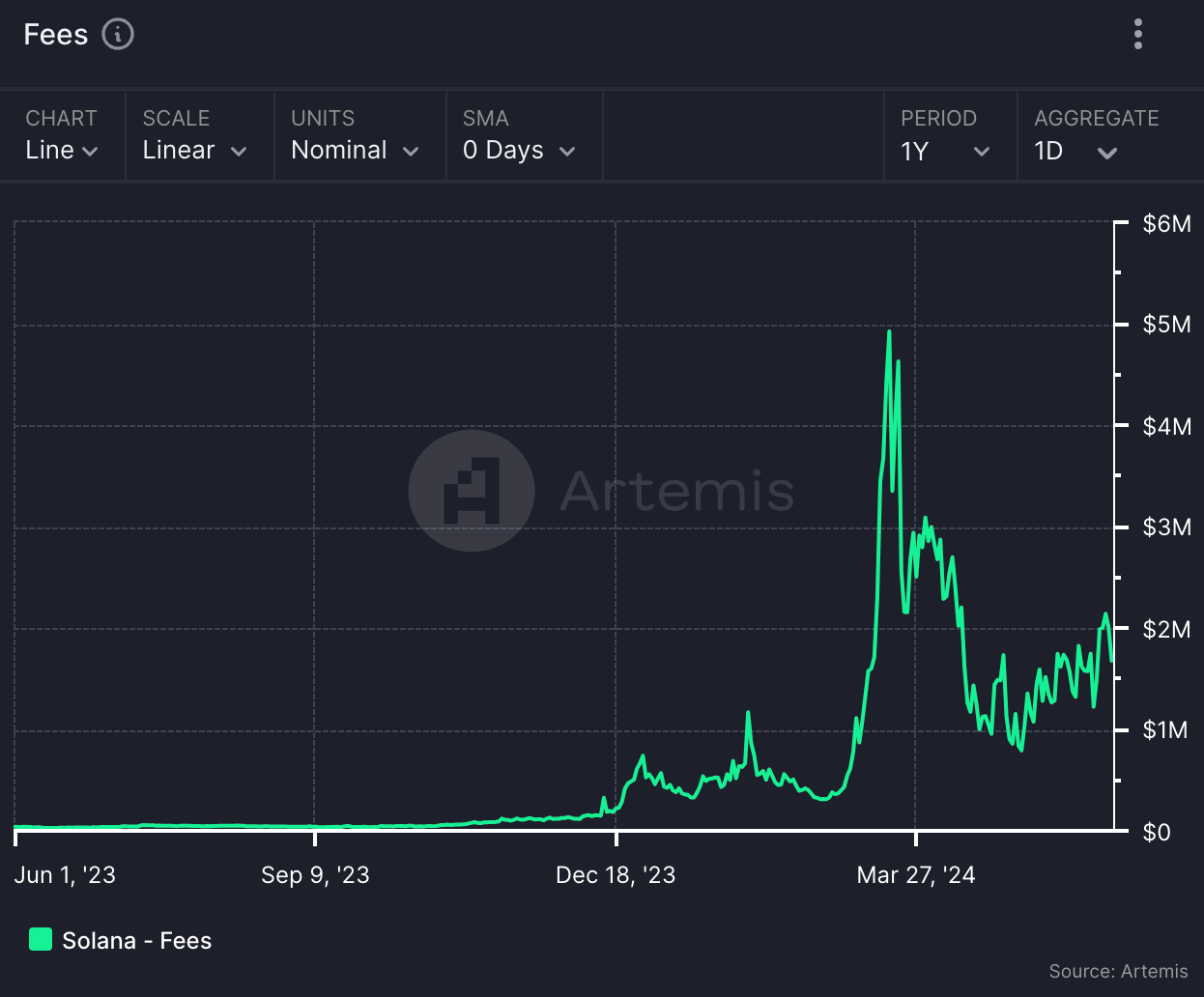
Takeaway: Solana’s trajectory shows it works and is working in a meaningful way. Clearly, Solana is here to stay.
#7: Ethereum
The Ethereum ecosystem has also made significant progress. There are two ways to achieve this growth: one is to focus on Ethereum itself, and the other is to view the chain system including Ethereum (i.e. the Ethereum roadmap) as a whole.
Ethereum itself has seen a significant increase in the number of monthly active addresses. The average number of active addresses over the past 30 days is up about 30% year-to-date and only about 10% below its 2021 peak.
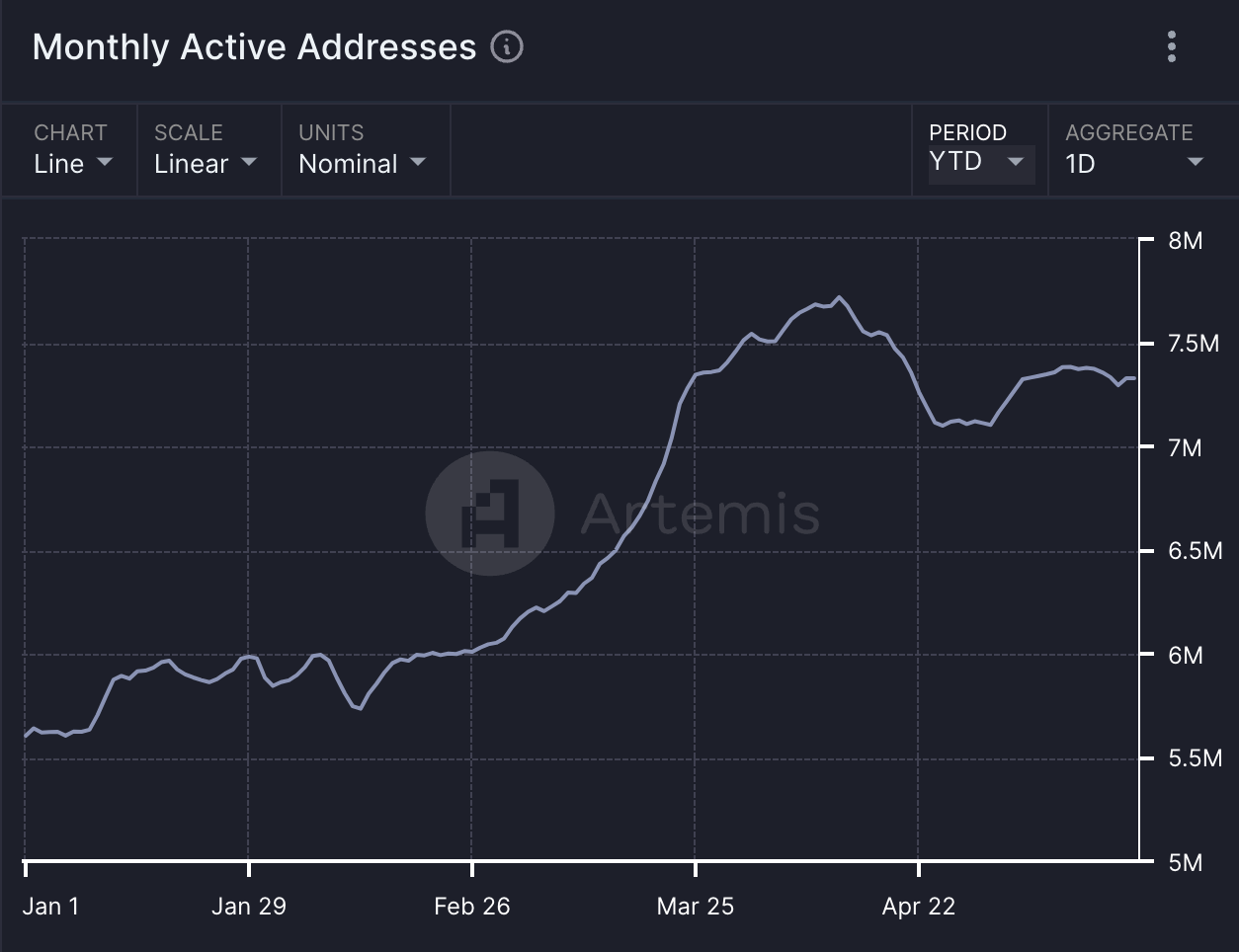
A more comprehensive look at the Ethereum ecosystem also shows significant signs of growth. The following chart summarizes the daily active addresses of the five top Ethereum-based chains - Ethereum, Arbitrum, Base, Optimism, and Polygon. These five chains were chosen in part because they have rich application ecosystems and a broad developer base.

Conclusion: Ethereum has become and will continue to be one of the most important ecosystems in the cryptocurrency space.
#8: Zora
Zora Chain (also known as Zora Network) has been running for about a year. During this time, the network has gradually gained a foothold. Weekly active users have grown by about 60% since the beginning of the year, and recently broke a new high of 250,000. In addition, the chain has a profit margin of about 34%, which means that Zora retains about one-third of the transaction fees collected by users.

The success of Zora Chain validates the idea that applications with sufficient distribution can begin to vertically integrate with other parts of the blockchain (such as blockspace) to achieve more attractive economic benefits.
#9: Coinbase
Coinbase has also had a strong start this year. It is listed as the custodian of 8 of the 11 Bitcoin spot ETFs. Its exchange business also continues to make significant progress - trading volume reached a high of $157 billion not reached since November 2021.
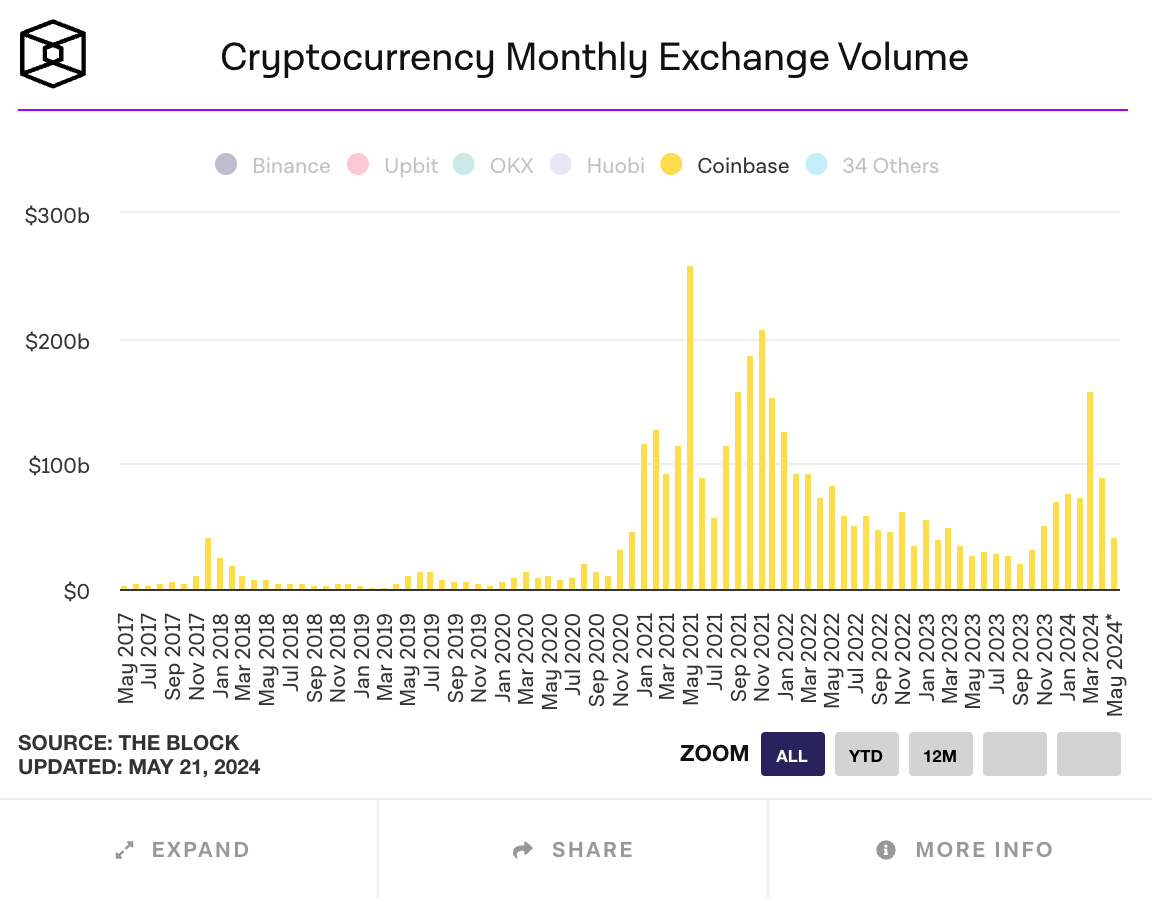
Trading fees remain a significant component of Coinbase’s revenue. In the first quarter, the platform’s trading fees exceeded $1 billion, accounting for about two-thirds of its quarterly revenue.
It is also worth noting that Coinbase continues to diversify its revenue sources beyond transaction-based fees. Blockchain reward revenue and custody fee revenue both doubled from the same period last year. Stablecoin revenue approached $200 million, and the growth of USDC's circulating supply offset the impact of lower interest rates. Coinbase One is Coinbase's membership package, with more than 400,000 subscribers. Base, as Coinbase's second-layer protocol, generates millions in on-chain fees every month.
Coinbase’s success further confirms what many had speculated until recently: a host of meaningful new business models are being built around crypto infrastructure.
#10: On-chain exchanges
On the mainstream Ethereum chain, the number of independent users (traders) of Uniswap has approximately doubled compared to six months ago.

One sign of a successful protocol is the ability to build successful businesses on top of it. We’ve seen this in the on-chain exchange space, with the revenue growth generated by the Uniswap Labs interface as an example:
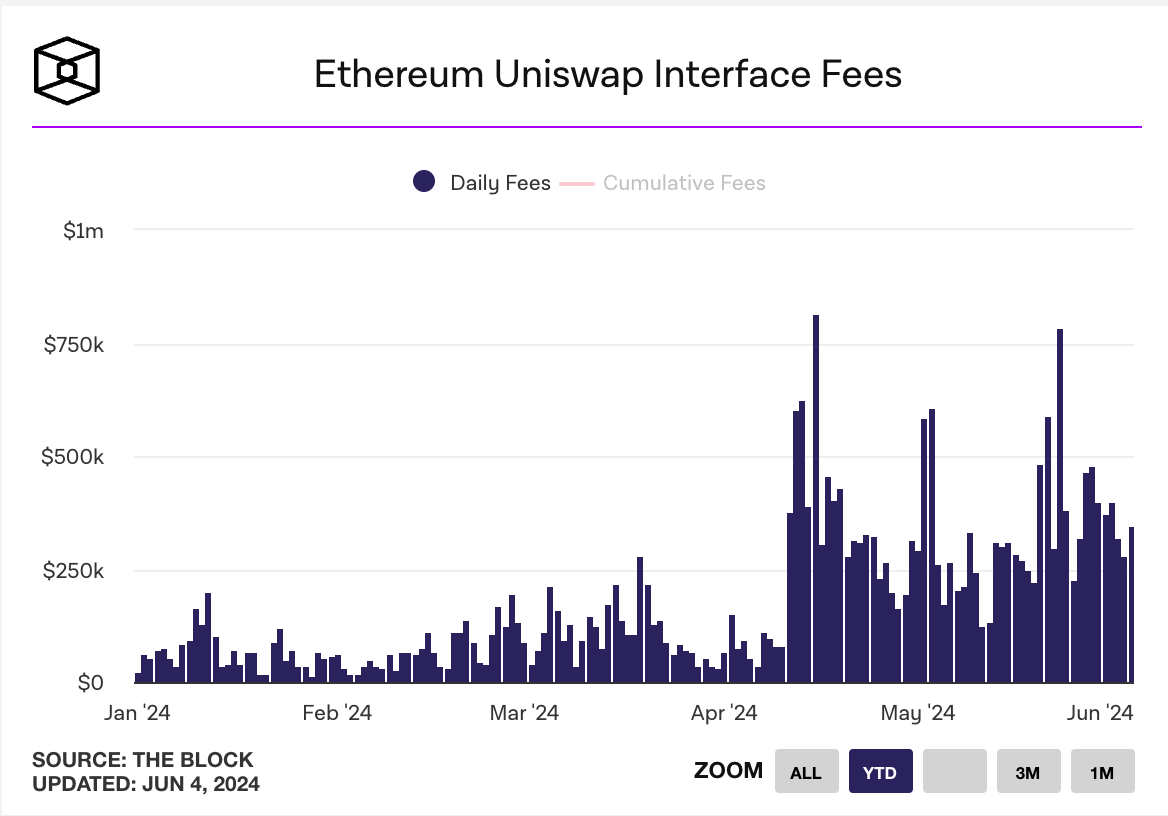
Recently, the seven-day moving average volume driven by Uniswap (the protocol) has even surpassed Coinbase:
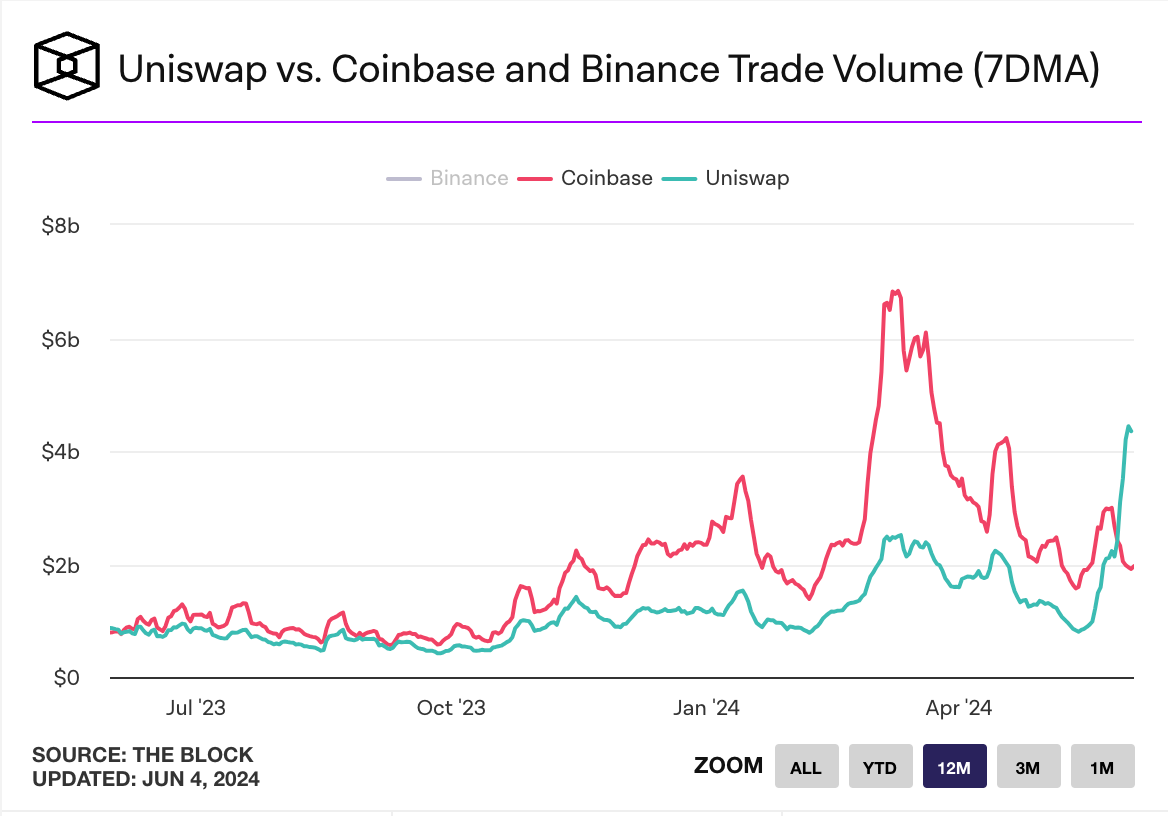
It’s worth noting that the growth of on-chain exchanges is not limited to Ethereum. On Solana, two leading decentralized exchanges, Orca and Raydium, have also achieved significant growth:
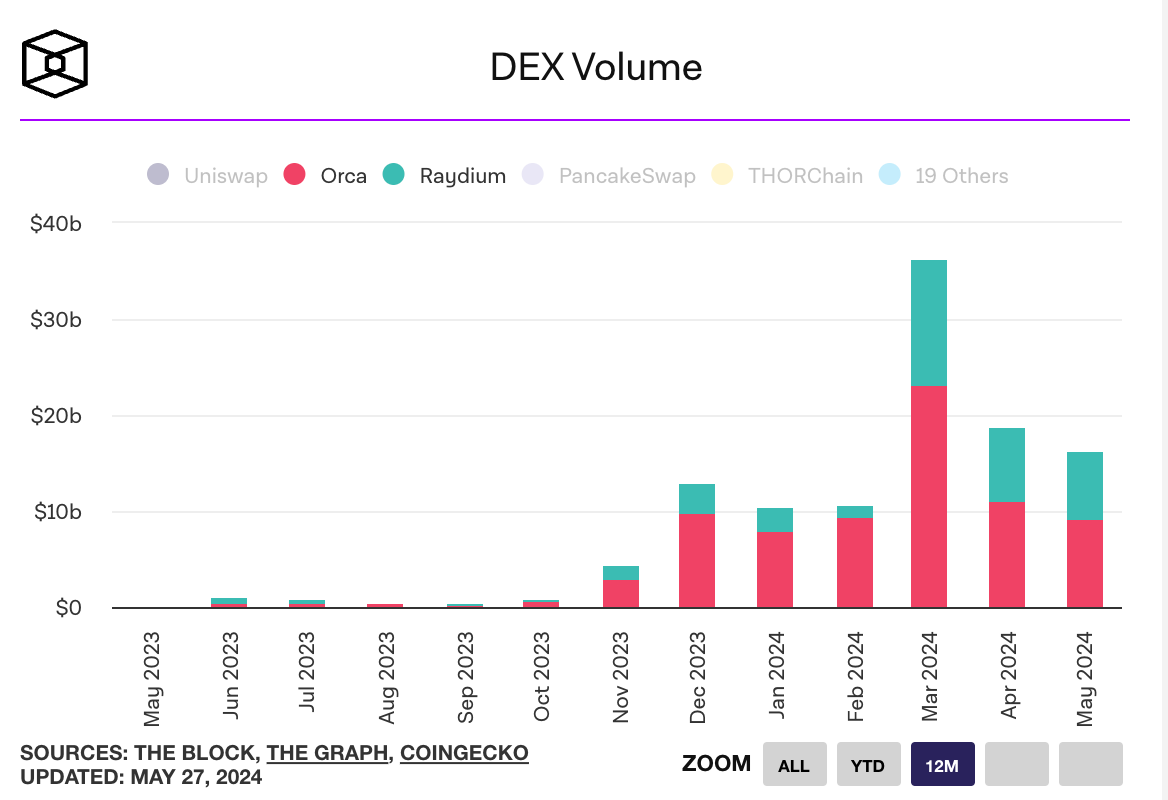
The tens (or even hundreds) of billions of dollars in value exchanged each month facilitated by on-chain protocols is no small matter. Both protocols and interfaces have become real revenue-generating projects. In the context of the existence of centralized institutions (such as interface businesses), I expect to see some of these profits reinvested to improve security, robustness, and user experience.
#11 (Bonus): Blackbird
Blackbird is a loyalty and rewards program for the restaurant industry built on cryptocurrency technology. When a user checks in at a Blackbird-connected restaurant, the app generates an NFT for them—not only a digital proof of their visit, but also a data point for restaurants in the network to gain insight into their customers’ dining habits. Currently, Blackbird primarily serves the New York metropolitan area.
Blackbird's daily user check-ins continue to rise.
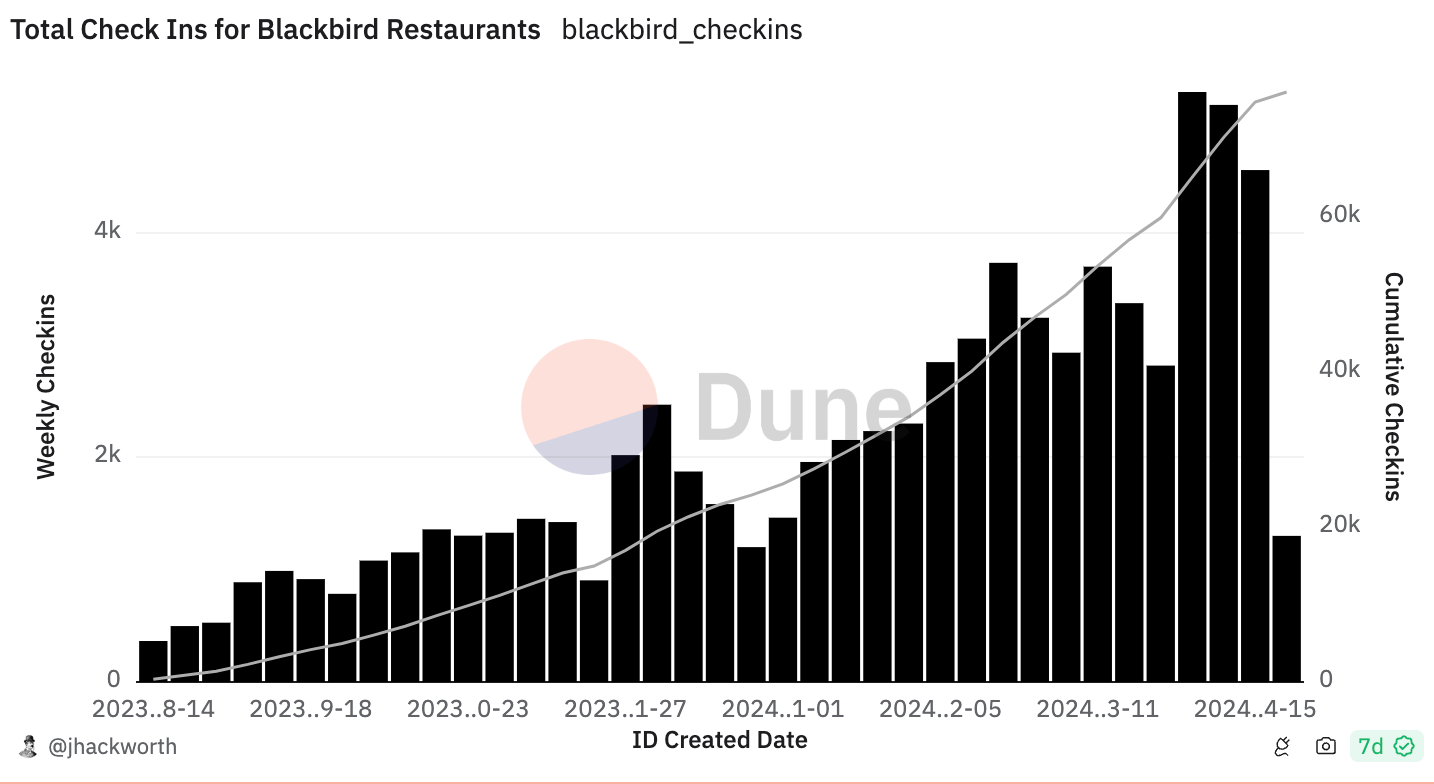
Personally, Blackbird has greatly enriched my dining experiences: whereas I used to let my friends decide where to eat, I've become more proactive in making restaurant recommendations (and rely heavily on the Blackbird app to identify which ones might be interesting places to eat).
Other things that happened
The rise of social networks and the emergence of new chains (mainly L2 and L3 in the Ethereum ecosystem) are two other notable trends in the past two quarters. Although it is premature to discuss their actual utility, it is worth mentioning that these trends are meaningfully affecting users' on-chain behavior and developers' business model development.
#1: Growth of Social Networking Apps
Many financialized social (“social-fi”) applications have emerged. Some of these applications have generated millions of dollars in fees. Friendtech and FantasyTop are two popular examples. Clearly, many users find these applications interesting and willing to participate. This provides users with exciting opportunities for new activities on the chain.
That said, I have reservations about the sustainability of some business models. Speculation alone doesn’t seem to be enough to guarantee long-term success. But that’s not a problem. With some tweaks, some apps might be able to develop more sustainable business models. Being compelling — even if speculative — offers a variety of possibilities for monetizing that interest. Of course, the crucial second step is the most challenging.
#2: The proliferation of new chains
Recently, we have witnessed the rise of many new chains, especially L2 and L3. For these chains in the Ethereum ecosystem, the underlying technology no longer seems to be the main competitive difference. Instead, brand power and community influence are the key to success. Take the L2 launched by Coinbase, Base, as an example, it highlights the symbolic significance of a strong brand. Despite the lack of direct token incentives commonly used by other chains to attract talent, the chain still enjoys a growing developer ecosystem.
So far, we have observed three strategies that chains have used to try to differentiate themselves:
- Underlying technologies, such as integrated chains vs. modular chains, or optimistic chains vs. zero-knowledge rollups.
- Chain economics, such as Canto, are the first blockchains I know of in recent years that attempt to redistribute transaction fees to developers in the ecosystem. Blast and Berachain are currently experimenting with various other revenue generation and economic distribution methods. It is unclear how sustainable these measures are - both in terms of economic generalization and in terms of providing a lasting competitive advantage.
- Brand and Community,The culture or reputation of a chain can provide an attractive halo for builders: it may enhance the perception that the developer has more support in the ecosystem (from the community or other developers), providing reputational security. In addition, the values promoted by the chain community may be consistent with the developer's own ideology, providing a concise identification for some consumers (such as "no one can be blamed for choosing a MacBook or similar product").
Mature chains usually have the above three elements. Take Ethereum and Solana as examples. Both have significant "effectiveness": Ethereum created the EVM, implemented EIP-1559 (a mechanism for redistributing ETH holders by destroying part of the transaction fees), and built a strong developer community and brand spirit around its technology. Solana popularized the concept of integrated blockchains, was the first to implement a low-fee business model, and forged a real community during the 2022-2023 economic downturn.
I predict that the next wave of chain differentiation will come from external integrations. This could include seamless access to other funding sources (e.g. through a Coinbase account), screens to conduct wallet KYC, or verifying an individual’s human identity. This is a vast design space that I’m very much looking forward to exploring further.
Looking ahead
Looking back over the past six months, my main takeaway is that while we are still discussing the same topics as we were 6-12 months ago, we are much more mature in terms of “what works”. As these businesses grow, many should transform into platforms, creating opportunities in their success. The problems that come with growth provide space for third-party solutions.
Projecting the growth of these major platforms also provides a basis for us to reflect on the direction of development. I am most concerned about new distribution forms and building blocks.
New distributions and better building blocks
On the distribution side, growth vectors I like include a larger scale Farcaster, the Telegram app with strong wallet functionality, and interfaces that continue to attract more users (such as the World App, which has reached 10 million users).
Meanwhile, there are many exciting new building blocks. Coinbase’s launch of Smart Wallet allows users to pay directly from their Coinbase accounts. Reservoir’s Relay protocol helps improve the user experience of bridging funds between chains, making a “one-click” checkout experience on-chain possible. The continued growth of World ID promises to provide a way to verify identity between humans and agents, and much more.
This may sound a little abstract. I sometimes get frustrated when I read something that sounds more like abstract hope than reality, so I’m here to help you avoid that by illustrating the function of these building blocks and new distribution channels with a concrete example.
Take modern advertising, a multi-billion dollar market that spans nearly every industry. Despite huge advances in attribution and targeting, it remains inefficient. Now imagine what an “ad” on Farcaster would look like:
- Companies can send coupons directly to the wallets of targeted customers (since every account has an associated wallet).
- The coupon may be based on a few mentions of similar products in a post created by the consumer or in a post liked by the user.
- Businesses can operate with confidence that data will always remain open and accessible (i.e. no need to worry about APIs being shut down or prices being jacked up), which enables them to invest in improving the effectiveness of this distribution channel.
- Budget is spent only when a consumer converts into a sale (i.e. uses the coupon).
Overall, this looks to be a win for businesses and consumers alike, thanks to open social graphs, embedded payment rails, and verifiable digital identities.
Mature chain looking to the future
Another important point to note in the “What Works” section is that there are several stable and evolving ecosystems (including Ethereum, Solana, and Bitcoin). These three platforms compete fiercely on their unique strengths, and each ecosystem’s strengths drive continued innovation and improvement in the other ecosystems. For example, Solana’s achievements with low cost and high throughput have inspired Ethereum’s continued innovation in both the base layer and layer 2 (L2). Similarly, Ethereum’s multi-client nature has set new goals for Solana in terms of client diversity, such as the upcoming Firedancer client. Bitcoin, the first digital currency to achieve widespread institutional adoption, is now also experimenting with introducing new programmability elements, such as ordinals, runes, and potential OP_CAT upgrades. Overall, I would summarize this phenomenon as each ecosystem is working tirelessly to achieve rough functional parity with the others. Looking at the current state of each ecosystem—and the positive characteristics exhibited by its peers—provides us with indications of possible directions for improvement.
This feels extremely positive. As a tennis fan, I tend to use a tennis analogy to explain this phenomenon. If there wasn't competition between Federer, Nadal, and Djokovic, they might not be able to reach the high level they are at. Each of them pushes the other to improve their game, which ultimately leads to truly excellent tennis. I think the same is true of the competition between various chains we see in the cryptocurrency space today. Due to the constant pressure to innovate, each chain is making greater and faster progress. Ultimately, the entire industry will experience significant net benefits as a result.
Some new thoughts
There is still a lot of ideal infrastructure and applications to be built. Here are some of the untapped areas that I am interested in, but have great potential:
Different forms of authentication. Credentials (certifications, proofs, etc.) are valuable resources on the chain, and their issuance timestamp and the ability to verify the issuer all benefit from the public ledger. For example, in workplace verification, an employer provides a credential that confirms that someone has served in the company for a certain period of time. In the crypto space, I have witnessed many attempts at authentication. I think the key is to identify those credentials that have actual economic value (such as employment verification) and dig deeper into these markets.
Price-Differentiated Assets (PDAs) represent goods that have real economic value, despite significant divergence in willingness to pay between market participants. Take restaurant reservations, for example. A recent study on the underground reservation market in New York City went viral: popular reservations were maliciously snapped up by bots and resold for thousands of dollars in a proprietary secondary market. From my perspective, if this financialization is inevitable, making these “assets” as transparent and accessible as possible would seem to be a positive outcome for both diners and restaurants. Restaurants would be able to more easily track the transfer history of reservations, while attracting more potential customers. Tokenization of reservations could even enable programmatic price caps or revenue sharing with restaurants, to name just a few possibilities. In many markets, many real assets with fundamental economic value are often mispriced or inefficiently undervalued due to opaque or restricted market access.
Regarding new models for token distribution, there are many opportunities to incentivize existing behaviors through token rewards as an additional reward for the activities they already participate in. Innovation efforts such as Blackbird are a notable example: although dining out is a common behavior, Blackbird's rewards system may change the behavior of some consumers in choosing where and how often to eat. This model can be widely applied to areas where people already invest time and money, but the consumption activities lack consistency or loyalty. In particular, I will focus on areas where merchants can benefit from some kind of alliance or cooperative effect (in terms of greater data and insights on consumer behavior), and there is a huge opportunity to improve customer loyalty (through push incentives).
Admittedly, whether these ideas are unique in their “why now” sense is an open question. In my opinion, they are mostly good ideas that work, have been around for a while but remain underexplored, and therefore worthy of further experimentation and investigation.
Concluding Thoughts
This reflection represents what I believe are many of the important changes happening in crypto recently, though not all of them. Some areas that were not mentioned but could or should be explored include the growth of permanent storage solutions (like Arweave), the evolution of defi protocols into true financial platforms (like Morpho), and Telegram’s deep promotion of TON.






